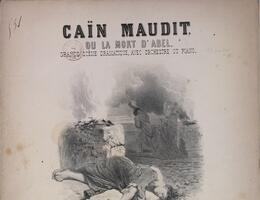Caïn maudit ou La Mort d’Abel

Described as a Grand scène dramatique, on a biblical subject and composed to a libretto by Saint-Hilaire, Caïn maudit ou La Mort d’Abel, was Onslow’s last vocal work. It received its first performance on March 12, 1846 in the salon of the Countess de Saint-Phal in Paris. Scored for bass soloist and orchestra or piano, the work was dedicated to the singer Hermann-Léon. At the work’s première, George Onslow himself accompanied at the piano; this performance was received with unanimous praise and, in all probability, the work persisted in this soloist-piano version. One of the keys of its success was its great formal flexibility which allows for the musical discourse to combine fully with the work’s dramatic progress. Marked by constant breaks in the tempi, its development follows the subtle emotional development, the expression of which is highlighted by bold and wide-ranging harmonies. Accurately reflecting the French taste for declamation, Onslow came up with a broad and minimally ornamented vocal line which, through its emphasis and lyricism, manages to stir the emotions. By means successively of invoking prayer, hatred, love and dread, through a vocal production ranging from murmuring very quietly à demi-voix up to the point of screaming, the ill-fated hero cultivates an ample range of expressions, reaching the highest point of his tessitura on his final words: “I am damned”. Whilst this work represents the composer’s only attempt at the scène lyrique, it is nevertheless a reminder that this genre was effectively and brilliantly executed in the nineteenth century for audiences of enthusiasts in the salons – and not just within the confines of the prestigious competition for the Prix de Rome to which Onslow never applied.

